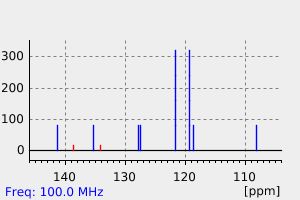1-(4-imidazol-1-ylphenyl)-1H-pyrazole | 630389-84-3
中文名称
——
中文别名
——
英文名称
1-(4-imidazol-1-ylphenyl)-1H-pyrazole
英文别名
1-[(4-imidazol-1-yl)phenyl]pyrazole;1-(4-imidazol-1-yl-phenyl)-1H-pyrazole;1-(4-imidazol-1-ylphenyl)pyrazole
CAS
630389-84-3
化学式
C12H10N4
mdl
——
分子量
210.238
InChiKey
WFYVLCOPNLQQKI-UHFFFAOYSA-N
BEILSTEIN
——
EINECS
——
-
物化性质
-
计算性质
-
ADMET
-
安全信息
-
SDS
-
制备方法与用途
-
上下游信息
-
文献信息
-
表征谱图
-
同类化合物
-
相关功能分类
-
相关结构分类
物化性质
-
沸点:381.4±25.0 °C(Predicted)
-
密度:1.22±0.1 g/cm3(Predicted)
计算性质
-
辛醇/水分配系数(LogP):1.6
-
重原子数:16
-
可旋转键数:2
-
环数:3.0
-
sp3杂化的碳原子比例:0.0
-
拓扑面积:35.6
-
氢给体数:0
-
氢受体数:2
SDS
上下游信息
-
上游原料
中文名称 英文名称 CAS号 化学式 分子量 1-(4-碘苯基)-1H-吡唑 1-(4-iodophenyl)-1H-pyrazole 368869-86-7 C9H7IN2 270.072 1-(4-溴苯基)咪唑 1-(4-bromophenyl)-1H-imidazole 10040-96-7 C9H7BrN2 223.072
反应信息
-
作为产物:描述:参考文献:名称:高效,温和的铜催化的芳基溴化物和碘化物的N-和C-芳基化反应。摘要:已经开发出用于氮杂环,酰胺,氨基甲酸酯的温和,有效的铜催化的N-芳基化方法,以及丙二酸衍生物的C-芳基化方法,可以提供高收率的芳基化产物,且具有出色的选择性。发现廉价的,空气稳定的催化剂体系将催化铜盐或氧化物与一组结构简单的螯合配体结合在一起,可大大促进咪唑与芳基溴化物或碘化物的N-芳基化反应。该反应显示与宽范围的芳基卤化物相容,包括空间受阻的,贫电子的和富电子的卤化物,可在特别温和的条件下(50-82摄氏度)提供芳基化产物。还研究了配体和催化剂载量的下限以及由带有那些配体的配合物相对于亲核体催化的Ullmann型缩合的范围。螯合席夫碱Chxn-Py-Al(1c)生成一种非常通用的铜催化剂,用于吡咯,吲哚,1,2,4-三唑,酰胺和氨基甲酸酯的N-芳基化;在温和的条件下(50-82摄氏度)将丙二酸二乙酯,氰基乙酸乙酯和丙二腈与芳基碘化物进行C-芳基化反应。就某些这类亲核试剂的乌尔曼型芳基化而DOI:10.1002/chem.200400582
文献信息
-
Method of forming a carbon-carbon or carbon-heteroatom linkage申请人:Taillefer Marc公开号:US20050234239A1公开(公告)日:2005-10-20The invention relates to a method of creating a carbon-carbon or carbon-heteroatom linkage by reacting an unsaturated compound bearing a leaving group and a nucleophilic compound. More specifically, the invention relates to the creation of a carbon-nitrogen linkage involving the arylation of nitrogenous organic derivatives. The inventive method consists in creating a carbon-carbon or carbon-heteroatom linkage by reacting an unsaturated compound bearing a leaving group and a nucleophilic compound providing a carbon atom or a heteroatom (HE) capable of being substituted for the leaving group, thereby creating a C—C or C-HE linkage. The invention is characterised in that the reaction is carried out in the presence of an effective quantity of a catalyst based on copper and at least one ligand comprising at least one imine function and at least one additional nitrogen atom as chelating atoms
-
Mild Conditions for Copper-CatalysedN-Arylation of Pyrazoles作者:Henri-Jean Cristau、Pascal P. Cellier、Jean-Francis Spindler、Marc TailleferDOI:10.1002/ejoc.200300709日期:2004.2Copper-catalysed N-arylation of pyrazoles with aryl or heteroaryl bromides or iodides, which can include functional substituents, was performed under the mildest conditions yet described, with excellent yields and selectivity, by the use as catalyst of a combination of cuprous oxide with a set of inexpensive, chelating oxime-type ligands not previously known to promote such reactions. Other original
-
Process for arylating or vinylating or alkynating a nucleophilic compound申请人:——公开号:US20030236413A1公开(公告)日:2003-12-25The present invention concerns a process for arylating or vinylating or alkynating a nucleophilic compound. More particularly, the invention concerns arylating nitrogen-containing organic derivatives. The arylating or vinylating or alkynating process of the invention consists of reacting a nucleophilic compound with a compound carrying a leaving group and is characterized in that the reaction is carried out in the presence of an effective quantity of a catalyst based on a metallic element M selected from groups (VIII), (Ib) and (IIb) of the periodic table and at least one ligand comprising at least one imine function and at least one supplemental nitrogen atom as the chelating atoms.
-
PROCEDE DE FORMATION D UNE LIAISON CARBONE-CARBONE OU CARBONE-HETEROATOME申请人:RHODIA CHIMIE公开号:EP1509502A1公开(公告)日:2005-03-02
-
US7202367B2申请人:——公开号:US7202367B2公开(公告)日:2007-04-10
表征谱图
-
氢谱1HNMR
-
质谱MS
-
碳谱13CNMR
-
红外IR
-
拉曼Raman
-
峰位数据
-
峰位匹配
-
表征信息
同类化合物
(SP-4-1)-二氯双(1-苯基-1H-咪唑-κN3)-钯
(5aS,6R,9S,9aR)-5a,6,7,8,9,9a-六氢-6,11,11-三甲基-2-(2,3,4,5,6-五氟苯基)-6,9-甲基-4H-[1,2,4]三唑[3,4-c][1,4]苯并恶嗪四氟硼酸酯
(5-氨基-1,3,4-噻二唑-2-基)甲醇
齐墩果-2,12-二烯[2,3-d]异恶唑-28-酸
黄曲霉毒素H1
高效液相卡套柱
非昔硝唑
非布索坦杂质Z19
非布索坦杂质T
非布索坦杂质K
非布索坦杂质E
非布索坦杂质D
非布索坦杂质67
非布索坦杂质65
非布索坦杂质64
非布索坦杂质61
非布索坦代谢物67M-4
非布索坦代谢物67M-2
非布索坦代谢物 67M-1
非布索坦-D9
非布索坦
非唑拉明
雷非那酮-d7
雷西那德杂质2
雷西纳德杂质L
雷西纳德杂质H
雷西纳德杂质B
雷西纳德
雷西奈德杂质
阿西司特
阿莫奈韦
阿考替胺杂质9
阿米苯唑
阿米特罗13C2,15N2
阿瑞匹坦杂质
阿格列扎
阿扎司特
阿尔吡登
阿塔鲁伦中间体
阿培利司N-1
阿哌沙班杂质26
阿哌沙班杂质15
阿可替尼
阿作莫兰
阿佐塞米
镁(2+)(Z)-4'-羟基-3'-甲氧基肉桂酸酯
锌1,2-二甲基咪唑二氯化物
锌(II)(苯甲醇)(四苯基卟啉)
锌(II)(正丁醇)(四苯基卟啉)
锌(II)(异丁醇)(四苯基卟啉)







